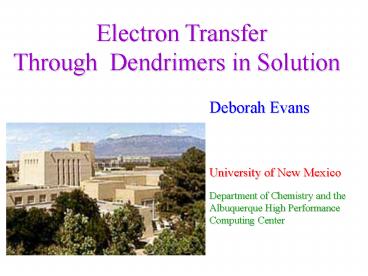Electron Transfer - PowerPoint PPT Presentation
Title:
Electron Transfer
Description:
Solvent-induced relaxation. Donor/acceptor energies. Side-branch chemistry ... Solvent relaxation effects: Dendrimer bridges. vs linear chains. Steady-state rates: ... – PowerPoint PPT presentation
Number of Views:116
Avg rating:3.0/5.0
Title: Electron Transfer
1
Electron Transfer Through Dendrimers in
Solution
Deborah Evans
University of New Mexico
Department of Chemistry and the Albuquerque High
Performance Computing Center
2
Dendrimers are synthetic realizations of Caley
trees
Electron Transfer
Energy Transfer
3
Electron Transfer Through Dendrimers
- Extensively branched macromolecules
Crooks et al, JACS, 120 (1998)
- form self-assembled monolayers
Abruna and coworkers Langmuir, 15 (1999)
4
Electro-active dendrimers and encapsulation
Cores Fe-S, porphyrin, ferrocene
Gorman et al, JACS, 121 (1999)
5
STM and cyclic voltammetry
Gorman et al JACS, 121 (1999)
6
Electron Transfer and Molecular Electronics
It's All About Contacts
K.W. Hipps,
Science The goal of building sophisticated
electronic devices from individual molecules has
spurred studies of single-molecules. The primary
problems facing the molecular electronics
designer are measuring and predicting electron
transport.
- Molecular wires
Molecular break-junction experiments
Reed et al JACS, 121 (1999)
7
Electron transport through linear chains
Nitzan et al, JPC, 104, 2001
bridge electron transfer interferences and
solvent dephasing
Pollard and Friesner, JPC, 99, 1995
8
- ET through solvated branched molecules
- Photo-induced intra-molecular transfer
Wasielewski et al JACS, 121 (1999)
9
Simulation of ET in solvated dendrimers
- Experiments have many competing processes
- Intra-dendrimer transfer
- solvent-induced relaxation / diffusion
- surface effects
- Surface-induced distortions
Crooks et al, Anal. Chem. , 71 (1999)
10
- Donors or Acceptors in solution
- D/A superexchange
11
Previous Modeling
Extended systems
- infinite Caley trees
- localized states
- dimensionality
- (simply connected branching)
Electron Transfer Pathways
Electron transfer rate T2 1 / K
K
Disorder creates 1-D pathways to enhance rate
Beratan, Onuchic, 1994
12
Solvent effects on ET
- Solvent-dependent ET rates
- flexible hydrophobic/hydrophilic
- rigid dendrimers
Classical MC and MD studies of 1-4 generations
Newhouse, Evans, 2000.
kJ/mol
13
Simulation of condensed phase ET
- Split-operator methods
- Time-dependent simulation of photo-
- induced electron transfer
- Solvent influence included as time-
- dependent fluctuations in the
- Hamiltonian
A modified Checkerboard algorithm exploits
the Caley tree connectivity
14
- Phenomenological Density Matrix Approach
- Liouville density matrix equation of motion
- Solvent influence included as phenomenological
- decay rates
- Steady-state rate constants determined for
- effective electron transfer rates through
- the molecular wire
- Ratner, Nitzan et al, linear D-B-A
15
- Redfield Approach
- Approach used for multi-level electron transfer
- Solvent included in the Redfield tensor elements
- Rijkl
- Bath correlation functions taken from the high-
- temperature limit
- Reduced density matrix of the system propagated
- using a symplectic integrator scheme
16
- Numerical Techniques
Photo-induced experiments (population dynamics)
Steady-State (rates)
constant
17
Solvated Dendrimer models
- Tight-binding model for dendrimer
- D E 1000 b 100
- Solvent system coupling
- coupling strength 5-10
- Assume Markovian limit
18
Results from numerical simulations
Effects of
- Dendrimer topology/geometry
- Solvent-induced relaxation
- Donor/acceptor energies
- Side-branch chemistry
- Thermal relaxation of the bridge
On
- electron transfer rates
- rectification
- switching
- conductance
19
Photo-induced Electron Transfer
(3N) (4N) (5N) condensed dendrimers
(14) (33) (52) extended dendrimers
20
Elicker, Evans, JPC 1999
21
Solvent relaxation effects
22
Steady-state rates
Dendrimer bridges vs linear chains
Evans et al , JPC, 2001
dendrimer linear
23
Generalized Chains
24
Forward Backward
25
Electronic Effects in Molecular Wires
molecule between two metal contacts
Conductance ( G(V)2) vs voltage (units of Eb)
26
Bridge Topology and Conductance
linear chains
side-branch structure
side-branch position
27
number of side-branches
longer bridges
DENDRIMERS
second-generation
third-generation
28
Steady-state rate kSS
Kalyanaraman and Evans, 2001
29
Landauer formula
30
Photoinduced Electron Transfer through a
dendrimer to acceptors diffusing in solution
Aida et al, JACS 118 (1996)
GOAL to measure kET for electron transfer
through the dendrimer framework
31
Simulations of solvent phase Photo-induced
Electron Transfer to diffusing acceptors
Mallick and Evans, 2002
- Classical MD simulation of diffusing viologens
- ET transfer rate to acceptors
- Electron dynamics through the dendrimer
following photoexcitation - (taking into account solvent dynamics)
32
Electron transfer rate from the dendrimer
periphery to the diffusing viologens
Depends on time Use Marcus expression with water
as the solvent
ET to viologens is irreversible treat the sites
as absorbing boundary
conditions
33
Classical Molecular Dynamics Simulations
NVE dynamics
dendrimer with viologen acceptors
in water
34
- Rate of transfer to viologen is
- a dynamic variable that evolves along a
simulation trajectory
L(t)
35
The second generation dendrimer
For the Aida experiments rate is dominated by
the intermolecular ET
36
The fourth generation dendrimer
Experimental studies
Observed kET 2.6 109 s-1
37
Conclusions
- Electron transfer in dendrimers
- photo-induced
- steady-state
- Electron transfer rate depends on
- branching structure
- enhanced over linear wires
- solvent dynamics time-scale and coupling
- strength
- intermolecular ET rate to diffusing acceptors
38
(No Transcript)
39
(No Transcript)
40
Dendrimer RDF
Malone, Evans 2000.
r































